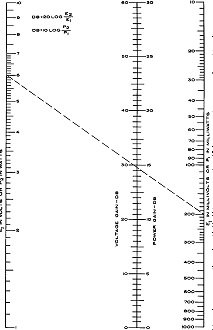|
August 1965 Electronics World
 Table
of Contents
Table
of Contents
Wax nostalgic about and learn from the history of early electronics. See articles
from
Electronics World, published May 1959
- December 1971. All copyrights hereby acknowledged.
|
Even with the ready availability
of programmable calculators and smartphone apps, there are still times when having
a handy-dandy nomograph printed out and hanging on the wall for quick reference
can be a great asset. This nomograph which appeared in a 1965 issue of Electronics
World magazine provided ready conversion between two different (input and
output) voltage and power values to
equivalent decibel values. It seems strange that the watts and voltage scale is
on the left and the milliwatts and millivolts scale is on the right. That might
be more intuitive for a nomograph of attenuation, but not - at least to me - for
positive gain as through an amplifier.
Amplifier Gain Nomogram
 By Max H. Applebaum By Max H. Applebaum
Warwick Electronics, Inc. Pacific Mercury Div.
Power and voltage gain of amplifiers with equal input and output impedances are
readily found.
To find the power gain of an amplifier, it is necessary to compute the ratio
of its output to input power, take the log and multiply by 10. When the input and
output resistances are equal, the voltage gain of the amplifier can be calculated
by multiplying 20 times the log of the ratio of output to input voltages.
This nomogram eliminates the tedious calculations involved, and gain can be determined
in a much simpler manner.
For values of 10n or 10-n times those on the E1
scale, subtract or add, respectively, n times 20 db from or to the values on the
voltage-gain scale. (n times 10 db from or to the power-gain scale when the P1
scale is used.)
For values of 10n or 10-n times those on the E2
or P2 scales, add or subtract respectively n times 20 db to or from the
values on the voltage-gain scale and n times 10 db to or from the values on the
power-gain scale.
Example: Find the voltage gain of an amplifier whose input and output resistances
are equal, when 6 volts output is measured for 200 mv. input.
Solution: Place one end of a straightedge over 6 on the left-hand scale and the
other end over 200 on the right-hand scale. Find 29.6 at the point where the straightedge
crosses the center scale. This is the voltage gain in db.
Posted September 12, 2022
(updated from original post
on 6/4/2015)
Nomographs / Nomograms Available on RF Cafe:
-
Parallel Series Resistance Calculator -
Transformer Turns Ratio Nomogram -
Symmetrical T and H Attenuator Nomograph -
Amplifier Gain Nomograph -
Decibel
Nomograph -
Voltage and Power Level Nomograph -
Nomograph Construction -
Nomogram Construction for Charts with Complicating Factors or Constants
-
Link Coupling Nomogram -
Multi-Layer Coil Nomograph
-
Delay Line Nomogram -
Voltage, Current, Resistance, and Power Nomograph -
Resistor Selection Nomogram -
Resistance and Capacitance Nomograph -
Capacitance Nomograph -
Earth
Curvature Nomograph -
Coil Winding Nomogram -
RC Time-Constant Nomogram -
Coil Design
Nomograph -
Voltage, Power, and Decibel Nomograph -
Coil Inductance Nomograph -
Antenna Gain Nomograph
-
Resistance and Reactance Nomograph -
Frequency / Reactance Nomograph
|










